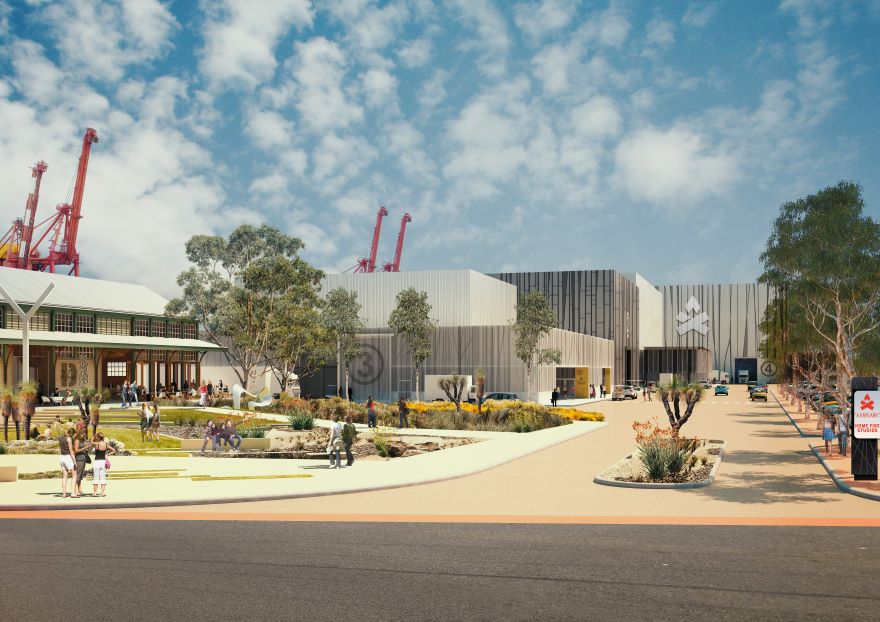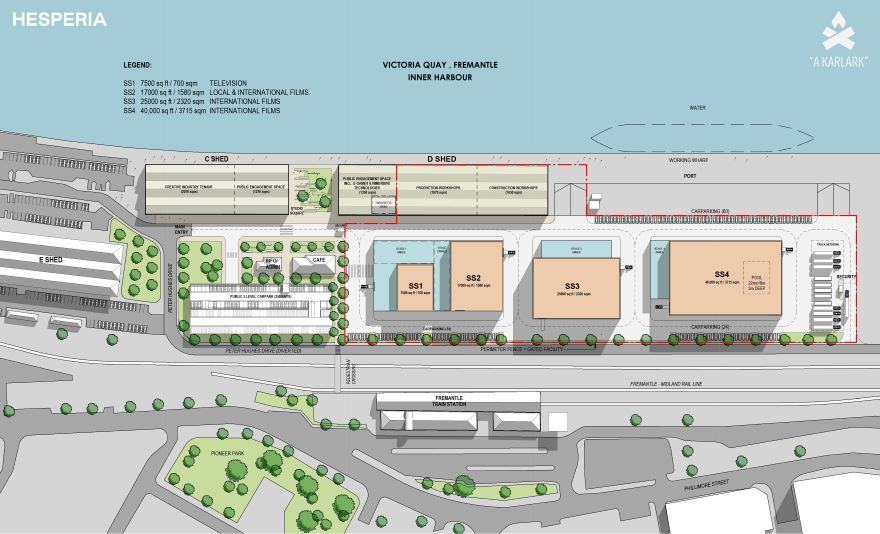The WA screen industry has fallen in behind the idea of Fremantle as the state’s film hub. But is Victoria Quay the best place for a movie studio? asks Mark Naglazas in the second of a series of articles on the most important piece of film infrastructure in our state’s history.
Lights! Cameras! Fremantle!
13 May 2021
- Reading time • 10 minutesFilm
More like this
- The great unknown
- Darkness lights the way
- Shining a beacon of light on our history
In the early days of motion pictures Thomas Edison used multiple patents to monopolise and control the burgeoning novelty. To escape the New Jersey-based inventor’s stranglehold on the nascent industry a group of independents decamped to the newly annexed Los Angeles neighbourhood of Hollywood, which had the advantage of blue skies, a variety of locations nearby and space for expansion.
Fast forward a century to the westward push of another film industry which has also reached the point in its history when it needs room to grow. But instead of the expandable spaces sought by Hollywood pioneers, a narrow strip of land between the port city of Fremantle and the harbour, Victoria Quay, has been chosen as the site for a $100 million world-class film-making facility.
More amazingly, the Western Australian government and their commercial partner Home Fire Creative Industries have targeted an area which, despite a series of developments such as the Maritime Museum and a Gage Roads brewery, is still a working port. If all goes to plan movie and television stars will be soon sharing the space with cruise ships, the latest batch of motor vehicles from Korea and boatloads of sheep bound for the Middle East.
But it wasn’t just a valuable piece of under-utilised real estate owned by the state and managed by the Port Authority that excited the McGowan Labor government in its drive to diversify the WA economy. They were swayed by the vision splendid of their preferred proponent, a consortium involving Little Creatures partners Adrian Fini and Howard Cearns, former ScreenWest CEO Ian Booth and producer Jamie Hilton, who see a movie studio in the heart of Fremantle as an opportunity to synergise with the city’s renowned creative community.
Instead of building the studio on the fringes of the metropolitan area, where facilities of this kind tend to be located, Home Fire believe that a state-of-the-art production facility within walking distance from the cappuccino strip will help plug the talent drain, lure creatives and crews back to WA and evolve into a hothouse for screen industry. Quite simply, Fremantle itself is as much the lure as the studio itself.

The bold move to locate in Victoria Quay four sound stages and the surrounding infrastructure needed to make a studio work, emerged from a committee headed by Fremantle MLA Simone McGurk that explored ways of activating an area that’s been languishing since the arrival of container shipping in the 1960s.
“Successive governments have failed to transform Victoria Quay and bring new jobs and vibrancy to the precinct. We now have the chance to realise this vision in the manner that complements Fremantle without diluting efforts to revitalise the CBD as past proposals, heavily centred on retail, threaten to do,” wrote McGurk in a letter to the Fremantle Herald.
While the idea for the film studio on Victoria Quay has been well received and masterfully sold – having Ben Elton, Tim Minchin and Kate Walsh stand next to Premier McGowan during the recent election campaign was the kind of showbiz touch that will be needed to make this expensive idea work – questions are still being asked within Fremantle and filmmaking communities.
“We should not be putting giant concrete bunkers in such a significant heritage area,” says Dutch-born Arundel Street resident Roel Loopers, a retired photographer, energetic blogger and a champion of responsible development in a city he cares about passionately.
“There are several other areas in and around Fremantle that would be more suitable, such as Jones Street in O’Connor, which was the preferred location of the City of Fremantle. Simone [McGurk] can talk all she wants about the wonderful things that would come with development but film studios are fenced-off compounds. The whole idea that it will attract thousands of people to Victoria Quay and activate the area is ridiculous.“
“Fremantle is a world-famous heritage town. Those values need to be added to, not diminished by juvenile hyperventilation,” says heritage activist John Dowson.
Loopers says he is not anti-development. He wants to see the city thriving, with jobs created and an influx of new residents. But he believes that everyone involved in promoting the studio “have stars in their eyes” and are ignoring the basic needs of the residents and visitors. “There is no masterplan for the whole area, which would include the Roundhouse and connectivity to the city from both ends behind the railway station.”
John Dowson, president of the Fremantle Society, is another long-time heritage activist concerned that a studio is a threat to a precinct of national importance. He is cynical about the Hollywood sell. “Fremantle is a world-famous heritage town. Those values need to be added to, not diminished by juvenile hyperventilation,” thundered Dowson in a letter to The Post.
Anywhere in Fremantle but Victoria Quay
While planning for the studios is still in its early days – the restrictions around the Market-Led Proposal process means I could not view the documentation – local screen practitioners are thrilled that the government is so interested in their industry. “You’d be an idiot to knock back a $100 million investment,” a veteran producer told me.

But there’s a real concern that the site is not optimal for film production. “Fremantle is the perfect place for a studio but not Victoria Quay,” argues producer Kate Separovich (Dirt Music), a resident of the area who would like nothing better than to be able to ply her trade a short drive from home.
“The major problem is the lack of space, which also restricts expansion. If you look at Fox Studios in Sydney they have Centennial Park nearby. If they need to spill out into an open area or build something of scale and bring it into the soundstage they have a large open area they can call upon. Centennial Park is almost their backlot. They did this on the Peter Rabbit sequel and is what they are doing on Thor: Love and Thunder.”
Secondly, a movie studio is a place of work, says Separovich. “We are an industry. Our interaction with the general public comes when the movie is released. We do not want the public getting close to where we are making our product. Even in Los Angeles, where you can pay for a studio tour, you get nowhere near where the work is being done.”
While she feels Victoria Quay is the wrong place for a major filmmaking facility – “A much better option is a vast open area just south of the city,” she argues – Separovich believes the Fremantle area is absolutely the right place for the proposed film hub.
“When you are trying to secure big-name actors, which is by far the most challenging part of the filmmaking process, they want to know where they’re going to stay. Fremantle is a place people know and they want to visit and stay,” she says.
The view from the city
During the first stages of the Market-Led Proposal process the City of Fremantle backed a group hoping to take over one of their properties, a vast disused building in the nearby suburb of O’Connor, and transform it into the film hub the industry so badly needs. However, Acting Mayor Andrew Sullivan is not disappointed that the Jones Street proposal was trumped by the Victoria Quay bid because of its potential to put a rocket under the port city.

“The trickle-down effect of a film studio in the heart of Fremantle will be massive,” Sullivan tells me over coffee in the west end of High Street which is now home to many of the creative industries that will benefit from a movie studio on Victoria Quay (as I write, the area is being used for the shoot of Renee Webster’s feature debut How to Please a Woman).
Sullivan says that he does not want Fremantle to be a sleepy dormitory suburb. “We want a vibrant seven-day-a-week economy. So you need industry. This is what film gives us. It creates employment, it creates activity. If you invest a million dollars in film you get seven times more activity than if you spend a million dollars on anything else. And the money gets invested locally,” says the former architect.
“When you lose industries like the port and you get this surge of gentrification we become what we don’t want to be. We don’t want Fremantle be the nursing home of the Western suburbs. All the creatives would move out if that were the case.”
Sullivan also dismisses concerns that the studio will disrupt other potential uses for Victoria Quay. “You have to remember that this is still a working port so there is a restriction on the kind of activities you have. A movie studio is a more suitable use of the space than many of the proposals we have on the table,” he argues.
Sullivan also believes that a studio will not monopolise land in Fremantle that could be used for other activities. “There is still a vast amount of land in Fremantle to be developed. It’s not like you’re putting all our eggs in one basket.”
While Sullivan is excited by the prospect of a studio in Victoria Quay activating a long-dormant area and bringing new energy and ideas to Fremantle, he understands the location may not prove to be suitable (the land is managed by the Port Authority whose prime directive is the smooth operation of the harbour).
“Whatever happens the City of Fremantle still wants to be part the conversation about where to put the studio. It would be a real tragedy not to have it here,” says Sullivan. “The studio has too much potential to connect to our other creative industries.”
Seesaw’s three-part series on the proposed Fremantle film studio concludes next week. Last week in “Hollywood or Bust?” Mark Naglazas asked if a $100 million state-of-the-art facility on Victoria Quay is what our screen industry really needs?
Pictured top: the Fremantle Markets are part of Fremantle’s iconic cappuccino strip. Photo by Fremantle Tourism Association
Like what you're reading? Support Seesaw.






